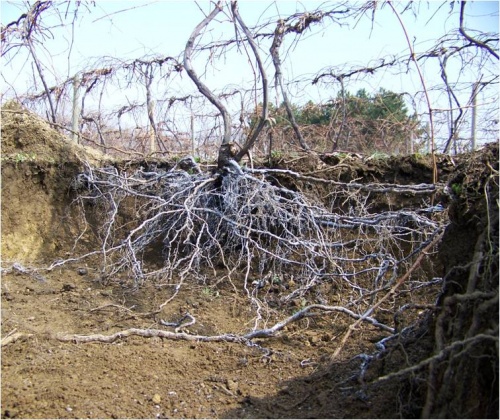Grapevines have a remarkable root system that allows them to thrive in a variety of conditions. Understanding how deep grapevine roots grow and spread out is key to proper planting and care. In this article we’ll explore the depths grapevine roots reach the factors impacting their growth, and tips for planting grapevines with healthy, robust root systems.
Average Grapevine Root Depth
On average, grapevine roots grow 1-3 meters (3-10 feet) deep. However, studies have recorded grapevine roots reaching as deep as 53 feet! The depth depends on factors like soil composition, water availability, and vine age.
In compact or clay soils roots grow closer to the surface. In loose, well-drained soils, vines can develop deeper roots exceeding 10 feet. As vines mature the root system expands deeper and wider. Young vines have roots less than 3 feet deep, while mature vines have taproots over 5 feet deep.
Though individual roots may plunge deep, most absorbent roots remain in the top few feet of soil. Grapevines develop a dense mat of fibrous feeder roots in the upper 12-18 inches of soil. This is where the highest concentration of nutrients exists. The deeper taproot anchors the plant and accesses water reserves.
Grapevine Root Spread
Not only do grapevine roots grow deep but they also spread widely. Under ideal conditions, grapevine roots can span over 35 feet wide! However, most root systems extend around 4-8 feet from the trunk.
The spread depends on factors like plant spacing and soil composition. Roots grow fastest horizontally in loose, fertile soils with ample moisture. In dry or compact soils, roots stay closer to the main taproot. Closely spaced vines also restrict root spread compared to vines spaced 8 feet or more apart.
Soil Conditions for Healthy Grape Roots
Grapevines can tolerate a range of soil types, but good drainage is critical. Roots rot in soggy soils. The best soils for grapevines are deep, fertile loams with a crumbly texture that retains some moisture while still draining well. Soils should have a pH between 6.0-6.5.
Before planting, test and amend the soil if needed. Dig planting holes 2-3 feet deep and wide. On slopes, dig terraces to help retain moisture. Amend backfill soil with compost to encourage root growth. After planting, use mulch and irrigation to maintain soil moisture, especially in drought-prone regions.
Caring for Young Grapevine Root Systems
Young vines need extra care for their shallow, fragile roots:
- Water frequently to keep roots moist, about 1-2 inches per week.
- Use mulch to conserve soil moisture and reduce weeds.
- Control weeds carefully to avoid damaging shallow roots.
- Avoid tilling around vines, which can sever developing roots.
- Don’t apply high-nitrogen fertilizer, which spurts top growth over root growth.
- Stake vines to prevent wind damage to the shallow root system.
As vines mature over 2-4 years, the roots will grow deeper and stronger. Mature vines are quite resilient, though ongoing mulching and weed control is still important.
Planting Tips for Healthy Grapevine Root Development
Here are some key tips for planting grapevines with healthy, extensive root systems:
- Choose rootstock suited to your soil and climate. This provides a strong taproot base.
- Prepare soil thoroughly to improve drainage and fertility for better root growth.
- Give vines ample space 8+ feet apart so roots can spread out.
- Plant vines slightly higher than ground level to avoid root rot.
- Dig large planting holes at least 2-3 feet deep and wide.
- Backfill with high-quality topsoil mixed with compost.
- Install a trellis system for vines to climb upon as they grow.
- Use fabric weed barriers and mulch to reduce weeds near vines.
- Water deeply and less frequently to encourage deep root growth.
With the right conditions, grapevine roots can plunge deep into the soil and spread widely to anchor the vine. Paying close attention to soil preparation, plant spacing, irrigation, and weed control will ensure your grapevine’s root system gets off to a strong start. This will lead to a healthier, more productive vine that can better withstand drought and deliver abundant fruit.
How To Plant Grape Vines at Home in the Back Yard.
FAQ
Do grapes have a deep root system?
Can you dig up and move grape vine?
What is the root structure of a grapevine?
Can grape vine roots damage foundations?
How deep do Grapevine roots grow?
The average depth of grapevine roots depends on the type of soil and climate the vine is growing in. Generally speaking, grapevines have roots that range from two to six feet deep. In sandy soils, the roots may be shallower, while in clay or loam soils, the roots can reach up to eight feet deep. The deeper the soil, the deeper the roots can grow.
How do Grapevine roots grow?
How Grapevine Roots Grow Compared to the above-ground portions of a grapevine, root structure and function is more of a mystery to most growers. Roots extract nutrients and water from the soil, and are also the dominant storage organ for carbohydrates and nutrients (vine reserves) in the dormant season.
How deep do vine roots grow?
When planted in this soil, the roots of the vine can reach depths of up to 10 feet. This is because the roots of the vine need to be able to reach the necessary nutrients and water that are found further down in the soil. As the vine grows, the roots will also grow, reaching deeper and deeper into the soil.
What type of soil does Grapevine grow in?
Fine-textured soil has a higher water holding capacity, and thus roots in silt and clay soil are normally shallower, while roots in coarse-textured soils are deeper. While grapevine can grow on it’s own root system, it can also be grafted onto a rootstock.

